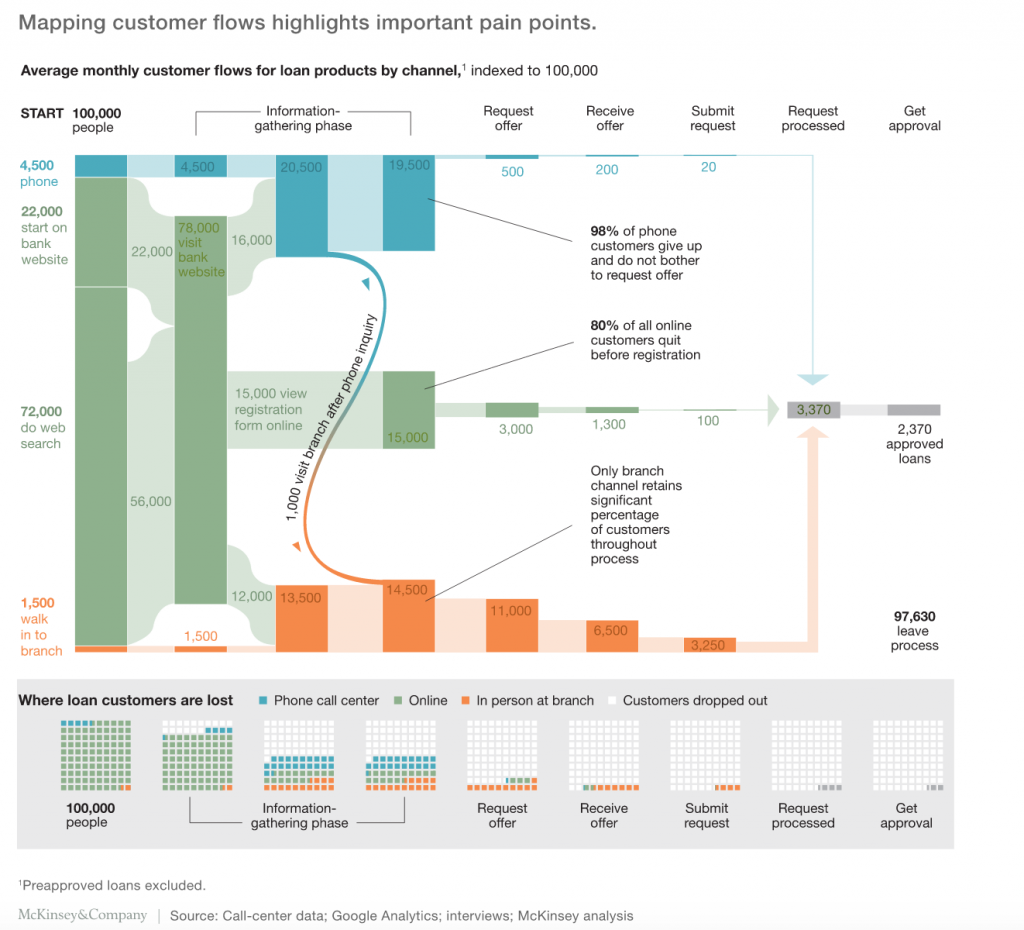Even though customer journey maps are now commonplace in large organisations, the design process for creating them is far from standardised. There can be all sorts of inputs, especially with the growing access and use of digital channels, and the output customer journey map (CJM) itself also comes in many different shapes and sizes.
Yet, the biggest risk to journey map design success is not using the wrong style or layout, or even under/over-representing a step in the journey.
Instead, the most common flaw is the customer framing of the design. Or to put it more bluntly, failing to centre the journey experience on the customer themselves, rather than the product or service being mapped.
To illustrate this issue, let’s explore an example from the financial services industry.
In July 2016, McKinsey released a paper on the rise of the omnichannel experience. The article showcased their study of how a regional bank moved customers through its process of applying for a loan. The customer-flow chart below illustrates the journey in a beautifully-styled graphic that McKinsey is known for.

Pretty though this chart is, it is titled as “highlighting customer pain-points”, and frames the customer experience as a conversion funnel. In other words, if the customer does not get to the end of the process where the loan request is submitted (and even approved), the journey is seen to have failed. McKinsey pointed to customers dropping out of the journey by not completing an application form or asking for a loan offer on the phone as evidence of this.
What McKinsey have actually created is a loan approval process map, not an omnichannel customer journey map. It has framed exit points in the process as “pain points”. This makes no recognition of whether it was right for the customer to choose to leave the process. From a customers’ perspective, ending their journey at the information-gathering step may have represented ‘success’, having learned and acquired the information they needed. But because McKinsey have framed the journey process around product conversion rather than customer needs, they perceive every journey that does not reach the loan-request step as a failure.
Contrast this approach with Jeff Bezos, CEO at Amazon, who committed to framing a successful Amazon customer journey goal as “providing the best information to give customers the right answer”. Amazon’s approach does not frame a product sale as the purpose of the customer journey. Instead, Bezos realised that the success end-point for the customer could be a whole range of things -perhaps a realisation that they did not need a certain item after all, or that they would be better off buying from an Amazon marketplace vendor than from Amazon itself.
Takeout: Capturing customer behaviour data and aligning it within a step-by-step product purchase process does not equate to a customer journey map. Yet, many organisations start at this point, with an already-established process, and a determination to make it more customer-friendly and efficient. For such firms, an initial improvement would be to try to answer the question:
“What could be a success end-point for a customer be at each step in the process journey?”
By shifting the framing design from process completion to customer success, this helps a company transition towards a better understanding of customer needs, and where they can be supported in a business workflow.
Ultimately, the company goal is to create a customer journey map framed around the customer needs and experience as seen from their own perspective, and only then to build support processes around them. By doing so, organisations can avoid the most common flaw in customer journey design.



